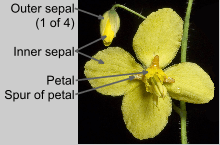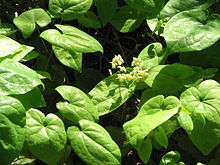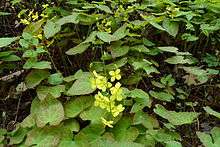Epimedium
Epimedium, also known as barrenwort, bishop's hat, fairy wings, horny goat weed, or yin yang huo (Chinese: 淫羊藿), is a genus of flowering plants in the family Berberidaceae. The majority of the species are endemic to China, with smaller numbers elsewhere in Asia, and a few in the Mediterranean region.[2]
| Epimedium | |
|---|---|
.jpg) | |
| Epimedium × versicolor | |
| Scientific classification | |
| Kingdom: | Plantae |
| Clade: | Tracheophytes |
| Clade: | Angiosperms |
| Clade: | Eudicots |
| Order: | Ranunculales |
| Family: | Berberidaceae |
| Genus: | Epimedium L.[1] |
| Type species | |
| Epimedium alpinum | |
| Synonyms[2] | |
| |
Epimedium species are deciduous or evergreen hardy perennials. The majority have four-parted "spider-like" flowers in spring.
The species used as a dietary supplement is Epimedium grandiflorum. It contains icariin, which is a weak PDE5 inhibitor in vitro. Its clinical effects are unknown.
Description


Species of Epimedium are herbaceous perennials, growing from an underground rhizome. Their growth habits are somewhat variable. Some have solitary stems, others have a "tufted" habit, with multiple stems growing close together. There may be several leaves to a stem or the leaves may be solitary, produced from the base of the plant. Individual leaves are generally compound, often with three leaflets, but also with more. Leaflets usually have spiny margins. The leaves may be annual, making the plant deciduous, or longer lasting, so that the plant is evergreen. The inflorescence is an open raceme or panicle, the number of flowers varying by species.[2]
Individual flowers have parts in fours. There are four smaller outer sepals, usually greenish and shed when the flower opens. Moving inwards, these are followed by four larger petal-like inner sepals, often brightly coloured. Inside the sepals are four true petals. These may be small and flat, but often have a complex shape including a nectar-producing "spur" that may be longer than the sepals. There are four stamens.[2]
One of the common names for the genus, bishop's hat, arises from the shape of the flowers, particularly where the spurs are longer than the sepals.
Taxonomy
The genus was given its name by Carl Linnaeus in 1753, in describing the European species E. alpinum.[1][3] The name is a latinized version of a Greek name for an unidentifiable plant, epimedion, that is mentioned in Pliny's Natural History (xxvii.57). The meaning of the original name is unclear.[4]
- accepted species (65)[5]
- Epimedium acuminatum
- Epimedium alpinum
- Epimedium baiealiguizhouense
- Epimedium baojingensis
- Epimedium borealiguizhouense
- Epimedium brachyrrhizum
- Epimedium brevicornum
- Epimedium campanulatum
- Epimedium chlorandrum
- Epimedium circinatocucullatum
- Epimedium coactum
- Epimedium davidii
- Epimedium dewuense
- Epimedium diphyllum
- Epimedium dolichostemon
- Epimedium ecalcaratum
- Epimedium elatum
- Epimedium elongatum
- Epimedium enshiense
- Epimedium epsteinii
- Epimedium fangii
- Epimedium fargesii
- Epimedium flavum
- Epimedium franchetii
- Epimedium glandulosopilosum
- Epimedium grandiflorum
- Epimedium hunanense
- Epimedium ilicifolium
- Epimedium jingzhouense
- Epimedium koreanum
- Epimedium latisepalum
- Epimedium leptorrhizum
- Epimedium lishihchenii
- Epimedium lobophyllum
- Epimedium macrosepalum
- Epimedium membranaceum
- Epimedium mikinorii
- Epimedium multiflorum
- Epimedium myrianthum
- Epimedium ogisui
- Epimedium parvifolium
- Epimedium pauciflorum
- Epimedium perralderianum
- Epimedium pinnatum
- Epimedium platypetalum
- Epimedium pinnatum
- Epimedium pseudowushanense
- Epimedium pubescens
- Epimedium pubigerum
- Epimedium pudingense
- Epimedium qingchengshanense
- Epimedium reticulatum
- Epimedium rhizomatosum
- Epimedium sagittatum
- Epimedium sempervirens
- Epimedium setosum
- Epimedium shennongjiaensis
- Epimedium shuichengense
- Epimedium stellulatum
- Epimedium sutchuenense
- Epimedium trifoliolatobinatum
- Epimedium truncatum
- Epimedium wushanense
- Epimedium zhushanense
Hybrids

Some artificial hybrids are cultivated in gardens. These include:[6]
- E. × cantabrigiense Stearn, hybrid between E. alpinum and E. pubigerum
- E. × perralchicum Stearn, hybrid between E. perralderianum and E. pinnatum subsp. colchicum
- E. × rubrum Morr., hybrid between E. alpinum and E. grandiflorum
- E. × versicolor Morr., hybrid between E. grandiflorum and E. pinnatum subsp. colchicum
- E. × warleyense Stearn, hybrid between E. alpinum and E. pinnatum subsp. colchicum
- E. × youngianum Fisch & C.A.Mey, hybrid between E. diphyllum and E. grandiflorum
Cultivation
Some varieties and hybrids have been in western cultivation for the last 100 to 150 years. There is now a wide array of new Chinese species being cultivated in the west, many of which have only recently been discovered, and some of which have yet to be named. There are also many older Japanese hybrids and forms, extending the boundaries of the genus in cultivation. Few genera of plants have seen such a dramatic increase in newly discovered species, primarily thanks to the work of Mikinori Ogisu of Japan and Darrell Probst of Massachusetts. The majority of the Chinese species have not been fully tested for hardiness nor indeed for any other aspect of their culture. The initial assumption that the plants would only thrive where their native conditions could be closely replicated have proven to be overly cautious, as most varieties are proving extraordinarily amenable to general garden and container cultivation.
The cultivar 'Amber Queen' is a recipient of the Royal Horticultural Society's Award of Garden Merit.[7]
Propagation
While they can be successfully propagated in early spring, epimediums are best divided in late summer, with the aim of promoting rapid re-growth of roots and shoots before the onset of winter. Several breeders (in particular Darrell Diano Probst, Tim Branney & Robin White) have also undertaken their own hybridization programmes with the genus. Various new nursery selections are gradually appearing in the horticulture trade, the best of which are extending the colour and shape range of the flowers available to the gardener.
Garden uses

Hugely popular as garden plants for centuries in Japan, epimediums are only just beginning to garner attention in the West. While they vary somewhat in their respective hardiness, all are essentially dwellers of the forest floor, and, as such, all require fundamentally similar conditions of moist, free-draining, humus-rich soil and cool shade, with some shelter for the newly emerging leaves. Some of the more robust varieties are often recommended as plants for dry shade, and whilst their tough foliage and stout rhizomes can allow them to grow successfully in such conditions, (and in more open, exposed positions too, in some instances) they will certainly not give their best. Furthermore, dryness and exposure will pretty much guarantee the early death of many of the newer and more delicate species.
Given suitable conditions most epimediums will form beautiful groundcover plants, often with magnificent new leaves tinted in bronze, copper and reds combining with a huge variety of flower colours and forms in spring. Handsome and dense-growing foliage remains present for much of the year, with the leaves often turning purple, crimson and scarlet in autumn in some forms, and remaining evergreen in others. With all varieties, however, the foliage is best cut off at ground level shortly before new leaves emerge, so as to fully reveal their beauty of form and colour. Ideally, a mulch should then be applied to protect the new growth from frosts.
Chemistry
Epimedium wushanense contains a number of flavanoids. 37 compounds were characterized from the underground and aerial parts of the plant. Among them, 28 compounds were prenylflavonoids. The predominant flavonoid, epimedin C, ranged from 1.4 to 5.1% in aerial parts and 1.0 to 2.8% in underground parts.[8]
References
- "IPNI Plant Name Query Results for Epimedium". The International Plant Names Index. Retrieved 2013-05-11.
- Ying, Junsheng; Boufford, David E. & Brach, Anthony R. (1994 onwards). "Epimedium". In Wu, Zhengyi; Raven, Peter H. & Hong, Deyuan (eds.). Flora of China (online). eFloras.org. Retrieved 2013-05-11. Check date values in:
|year=(help) - Linnaeus, Carl von. 1753. Species Plantarum 1: 117 in Latin
- Johnson, A.T.; Smith, H.A. & Stockdale, A.P. (2019), Plant Names Simplified : Their Pronunciation Derivation & Meaning, Sheffield, Yorkshire: 5M Publishing, ISBN 9781910455067, p. 55
- The Plant List 2013.
- Beckett, K., ed. (1993). "Epimedium". Encyclopaedia of Alpines : Volume 1 (A–K). Pershore, UK: AGS Publications. ISBN 978-0-900048-61-6. pp. 437–441.
- "Epimedium 'Amber Queen'". www.rhs.org. Royal Horticultural Society. Retrieved 7 June 2020.
- Li HF, Guan XY, Ye M, Xiang C, Lin CH, Sun C, Guo DA.,"Qualitative and quantitative analyses of Epimedium wushanense by high-performance liquid chromatography coupled with diode array detection and electrospray ionization tandem mass spectrometry." J Sep Sci. 2011 May 10;
Bibliography
- Stearn, William Thomas (November 1938). "Epimedium and Vancouveria (Berberidaceae), a monograph". Journal of the Linnean Society of London, Botany. 51 (340): 409–535. doi:10.1111/j.1095-8339.1937.tb01914.x.CS1 maint: ref=harv (link)
- Stearn, William T. (2002) [1938]. Green, Peter Shaw; Mathew, Brian (eds.). The genus Epimedium and other herbaceous Berberidaceae. (including the genus podophyllum by Julian Shaw, illustrations by Christabel King) (Revised ed.). Kew: Royal Botanic Gardens. ISBN 9781842460399.CS1 maint: ref=harv (link)
- Avent, Tony (March 2010). "An overview of Epimedium". The Plantsman: 10–17.
- "Epimedium". The Plant List (2013). Version 1.1. 2013. Retrieved 20 December 2016.